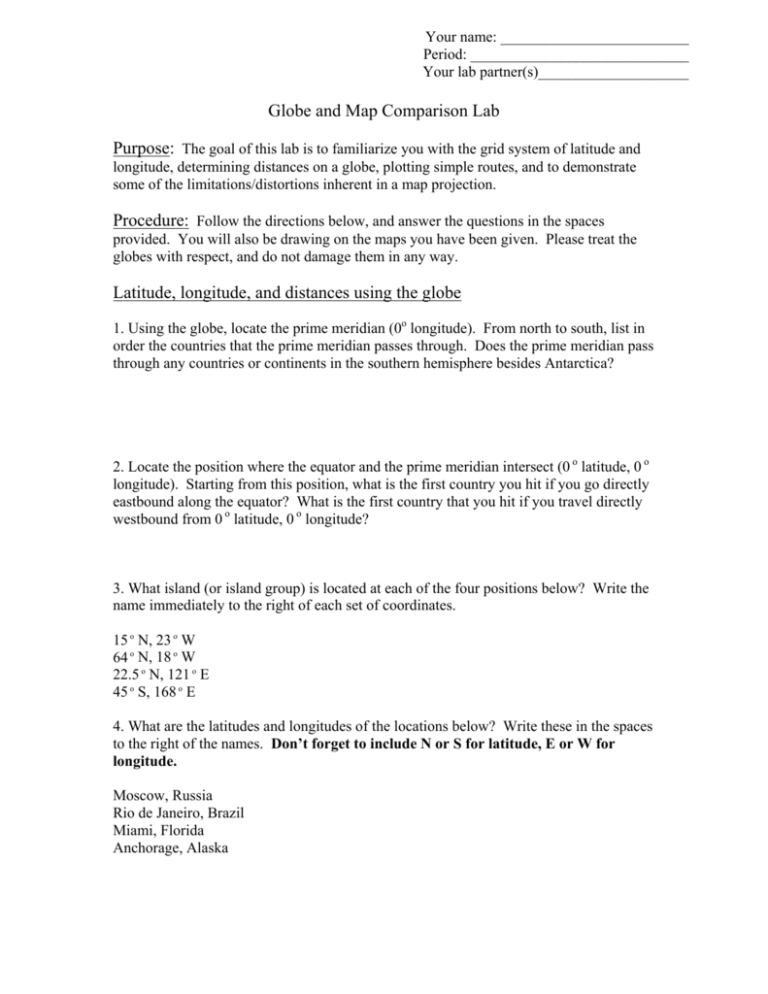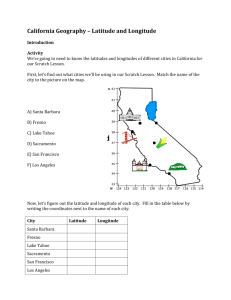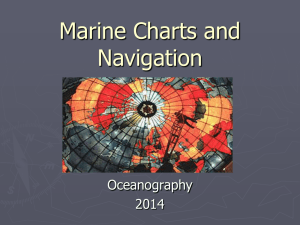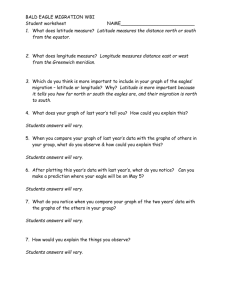Globe and Map Comparison Lab Latitude, longitude, and distances
advertisement

Your name: _________________________ Period: _____________________________ Your lab partner(s)____________________ Globe and Map Comparison Lab Purpose: The goal of this lab is to familiarize you with the grid system of latitude and longitude, determining distances on a globe, plotting simple routes, and to demonstrate some of the limitations/distortions inherent in a map projection. Procedure: Follow the directions below, and answer the questions in the spaces provided. You will also be drawing on the maps you have been given. Please treat the globes with respect, and do not damage them in any way. Latitude, longitude, and distances using the globe 1. Using the globe, locate the prime meridian (0o longitude). From north to south, list in order the countries that the prime meridian passes through. Does the prime meridian pass through any countries or continents in the southern hemisphere besides Antarctica? 2. Locate the position where the equator and the prime meridian intersect (0 o latitude, 0 o longitude). Starting from this position, what is the first country you hit if you go directly eastbound along the equator? What is the first country that you hit if you travel directly westbound from 0 o latitude, 0 o longitude? 3. What island (or island group) is located at each of the four positions below? Write the name immediately to the right of each set of coordinates. 15 o N, 23 o W 64 o N, 18 o W 22.5 o N, 121 o E 45 o S, 168 o E 4. What are the latitudes and longitudes of the locations below? Write these in the spaces to the right of the names. Don’t forget to include N or S for latitude, E or W for longitude. Moscow, Russia Rio de Janeiro, Brazil Miami, Florida Anchorage, Alaska 5. Using a piece of string, measure the distance from 0 o latitude, 0 o longitude to a position 15 o due north along the prime meridian (15 o N latitude, 0 o longitude). Remove the string from the globe, and stretch the string alongside a ruler to obtain the distance in millimeters. How many millimeters was it? Next, using the same technique, measure and record the distance in millimeters between 60 o N latitude, 0 o longitude and 75 o N latitude, 0 o longitude. Is the physical distance in millimeters of 15 o of latitude the same everywhere on the globe (i.e., were the distances in millimeters the same)? Length in millimeters of 15 o of latitude on globe = __________mm 6. Using a piece of string in a similar manner as you did in step 5 above, measure and record the distance in millimeters from 0 o latitude, 0 o longitude to a position 15 o due west (0 o latitude, 15 o W longitude). Now measure and record the distance in millimeters between positions 60 o N latitude, 0 o longitude and 60 o N latitude, 15 o W longitude. Compare the two measurements - is the physical distance in millimeters of 15 o of longitude the same everywhere on the globe (i.e., were the distances in millimeters the same)? Why do you think the definition of the nautical mile is specifically 1 minute of latitude, rather than 1 minute of longitude? Answer: 7. Assuming that the earth is a perfect sphere (it isn’t, but this assumption is acceptable for this calculation), what is it’s circumference in nautical miles? Show your work. Remember that 1 o of latitude = 60 nautical miles, and there are 360 o in a circle. 8. You can determine a conversion factor for converting millimeters on your globe to nautical miles by using the information you gathered in step 5 above. Specifically, divide the distance in nautical miles of 15 o of latitude (this is 900 nautical miles, see below) by the number of millimeters of 15 o of latitude on your globe (your answer for step 5 above). Calculate this conversion factor for your globe (please see formula below). 15 o latitude x 60 nautical miles 1 o of latitude = 900 nautical miles 900 nautical miles (= nautical miles in 15 o of latitude) __________________________________________ = Nautical miles per mm of string Length of string in millimeters between two points (this is your conversion factor) on the globe separated by 15 o latitude (your answer for question 5 above) Your calculation: 9. Using the string, ruler, and the conversion factor from number 8 above, measure and record the distance in nautical miles of the shortest route between San Francisco and Tokyo. To do this, stretch the string between San Francisco and Tokyo over the curved surface of the globe so that the string between the cities is as short as possible. Mark/note the positions of the two cities on the string with your fingers, remove the string from the globe, stretch the string out straight on the desk, and measure the distance between the cities in millimeters using a ruler. Multiply this distance by the conversion factor determined above; you now have the shortest distance between San Francisco and Tokyo in nautical miles. This shortest route between two points on the earth’s surface is called a great circle route. Shortest distance in mm between Shortest distance between San Francisco and Tokyo X Conversion Factor = San Francisco and Tokyo in determined from globe (great (number 8 above) nautical miles circle route) Your calculation: Map distortion 10. Look at the cylindrical projection map you have been given. Notice the relative sizes and shapes of Greenland, Alaska, and the continental United States. Now compare the relative sizes and shapes on this map with the relative sizes and shapes on the globe. Where is the distortion on the map greatest? What is the nature of this distortion (e.g., are things appearing bigger or smaller than they should as you go poleward on the map)? 11. Take a look at the homolosine projection map on the last page (“Figure 1-1”) – this is the same map you used in a previous lab. Notice the relative sizes and shapes of Greenland, Alaska, and the United States. Compare this to the globe and the cylindrical projection map – which map (homolosine or cylindrical projection) does a better job of depicting the relative sizes/surface areas of major features (i.e., which matches the globe most closely)? 12. Using your cylindrical projection map, measure and record the distance in millimeters from 0 o latitude, 0 o longitude to a position 15 o due north along the prime meridian (15 o N latitude, 0 o longitude). Next, using the same technique on your map, measure and record the distance in millimeters between 60 o N latitude, 0 o longitude and 75 o N latitude, 0 o longitude. Is the physical distance in millimeters of 15 o of latitude the same everywhere on the cylindrical projection map (i.e., were the distances in millimeters the same)? 13. Look again at the cylindrical projection world map you have been given – find San Francisco and Tokyo on it. Now, reposition the string on your globe as you did above in number 9 to show the shortest (great circle) route between San Francisco and Tokyo (stretch the string taught between the two cities). As best you can, draw onto your map the actual shortest route between San Francisco and Tokyo shown on your globe. One way to do this is to note some of the coordinates that the string on your globe lies on. Mark some of these same locations on your map, and draw a smooth curve through them from San Francisco to Tokyo. 14. Draw a straight line on your cylindrical projection map connecting San Francisco and Tokyo; you’ll notice that this route runs basically east-west. On your globe, position the string to represent this route - it will connect San Francisco and Tokyo, and the string should run directly east-west parallel to the lines of latitude shown on your globe. Use your fingers on the string to note the positions of the two cities. Now remove the string from the globe, stretch it out straight on the desk, and measure the distance between San Francisco and Tokyo in millimeters. Convert this distance to nautical miles using the conversion factor you calculated in number 8, then determine and record the difference in the length of the shortest route on the globe (step 9 above) with the east-west route on the globe (which corresponds to the apparent shortest route on the map). Distance in mm between San Francisco and Tokyo, east-west route on globe X Conversion factor (number 8 above) = Distance in nautical miles between San Francisco and Tokyo, east-west route Your calculation: Distance between San Francisco and Tokyo in nautical miles, east-west route on globe calculated above (apparent shortest route on map) Your calculation: Shortest distance between _ San Francisco and Tokyo in = nautical miles (number 9 above) Difference 15. Using the cylindrical projection map, what are the latitudes and longitudes of the locations below? Please write them next to the names, and don’t forget the N or S for latitude, E or W for longitude. Los Angeles, California New York, New York Seattle, Washington Putting it all together – Please answer these two questions on your own, without consulting your partner 16. Is a cylindrical projection map a great choice for comparing the relative sizes/surface areas of major features of the earth? Why or why not? 17. If you draw a straight line on a cylindrical projection map between two locations (a departure point and a destination), have you plotted a route that will take you from one place on the earth’s surface to another with certainty? Is there a limitation or caveat associated with this route? If so, what is it?






